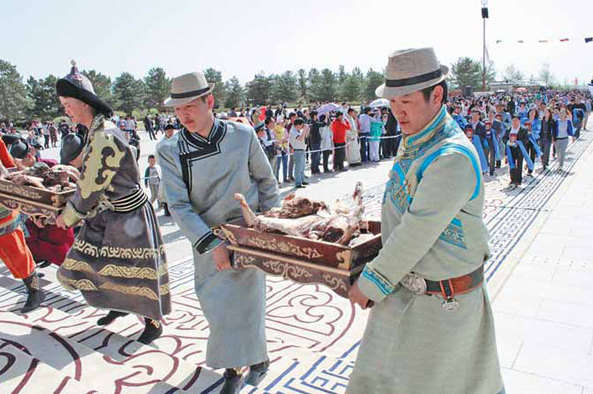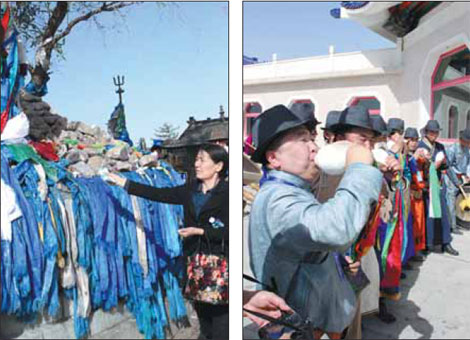In memory of the Khan
Updated: 2013-05-09 06:02
By Wang Kaihao (China Daily)
|
||||||||
|
People offer sacrifices at the annual spring event Tsagaansurek at the Mausoleum of Genghis Khan. Photos by Wang Kaihao / China Daily |
Genghis Khan was the greatest Mongolian in the memory of his people. But there is one clan of Mongolians that has made preserving his memory its special duty. Wang Kaihao reports from Ordos, Inner Mongolia.
The morning sunshine bathes the Mausoleum of Genghis Khan in Ejin Horo Banner, the Inner Mongolia autonomous region, with a golden glow. Tranquility has just returned to this Mongolian ethnic group's holiest place on the Ordos Plateau. On April 30, more than 70,000 pilgrims from all over China and overseas congregated for Tsagaansurek, the peak event of a one-week annual spring sacrifice, which means "a white herd" in Mongolian. Govaa, a woman from the nearby pasture region, steps into the main palace which is housed in a building shaped like a cluster of three Mongolian yurts. She removes her stylish sunglasses, takes out a huge piece of roast lamb and two bottles of fine Moutai liquor. She then holds out a blue khatag - a long piece of silk that denotes good wishes and blessings - and kneels down in front of the golden statue of Genghis Khan.
The palace resounds with a priest's voice reading an ode to the Khan.
"There were too many people yesterday and we were blocked outside due to traffic control," Govaa stands up about half an hour later. "But, I can never be absent at such an important rite. Nobody dictates that I come, but I have to be responsible to our Emperor Lord, who always lives in my heart."
She is one of the Darhad people, descendents of Bo'orchu and Muqali, two famous Mongol generals, who had the special privilege of guarding the Khan's mausoleum after his death in 1227. For this, they were also exempted from military duties and taxes.
Though no one knows where the Khan was actually secretly buried. This mausoleum commemorating the Khan guards some of his belongings and images, as well as spear-shaped totems called sulde, which are sacred to all Mongolians.
The Darhad has scrupulously kept an oil lamp in the palace burning uninterruptedly for nearly 800 years as part of their sacred duties.
About 6,000 Darhad people now live in Ejin Horo, which translates to "courtyard of the Emperor Lord". More than 30 still perform full-time duties guarding the place and hosting dozens of rituals every year, among which Tsagaansurek is the biggest.
The complicated process of rituals has stayed unchanged through centuries and is among the first list of national intangible cultural heritage created in 2006.
Darhad men still sing a long ballad using an unidentified ancient language during the major rituals accompanied by a horse-head sacrificial instrument called the charig. The ballad is commonly called "the song of heaven" but no one knows its origin.
Even Khasbileg and his father, the only two men in the mausoleum who are able to read the characters, do not know their meaning. They are also reticent and reluctant to say much about this strange rite.
Khasbileg's father claims he cannot speak Mandarin, and his 16-year-old son, who looks energetic on the basketball court outside, suddenly falls silent during the interview.
They are from a family with one of highest positions among Darhad people. Since only men can be priests, Khasbileg has felt blessed to have a son.
Most of the priests appear mysterious and keep solemn faces before the pilgrims, but Erdenesunver, a 38th-generation Darhad, is uncommonly approachable.
"Each family has its own duty covering certain part of the rituals," the 61-year-old retired priest says. "Each has some unique techniques, like singing the song of heaven.
"Our family's duty is to care for the main palace," he continues, although he stops at revealing more details.
According to Erdenesunver, there were 500 families safeguarding the mausoleum when Kublai Khan (1215-94) established eight white yurt palaces and launched the seasonal rituals.
The eight yurts had remained until 1939, when the mausoleum was moved westward to escape possible Japanese invasion. The mausoleum was moved back in 1954 and the current palace, where the yurts are gathered together, was built two years later.
He says there is no written record of the rituals but the rites are passed on through word of mouth, generation to generation. A golden book recording ancient shamanistic odes and anthems, which are sung during the rituals, had been well-preserved until it was lost in the 1960s.
Erdenesunver spent 15 years rummaging among historical files and priests' memoirs before he finally resurrected it in 2007. Public sacrifices gathering representatives from all banners in Ordos during Lunar New Year and Tsagaansurek have also been recovered in recent years, after the tradition was abandoned for decades.
"It is good to see the Darhad has attracted public interest in the traditions again after so long," he says. "I am overjoyed to see visitors from overseas."
However, he also regrets that the Darhad phalange guarding the mausoleum has been shrinking, eroded by the desire to look for better opportunities in the big cities.
Erdenebileg, 39, is a 39th-generation Darhad from a family which has traditionally raised white horses for the rituals. He attended medical school and ran a clinic in a nearby town for six years before he decided to return to the mausoleum in 2000. Though he mostly manages logistics, he still feels proud of what he is doing.
"It will take a lifetime to learn our own culture," he explains. "Why shouldn't I come back to the place that gave life to me?"
Ejin Horo is among Inner Mongolia's wealthiest banners because of its rich coal mines, and the local government has relocated most of the Darhad to villas.
Senge is a local civil servant, and he moved into a two-story villa without having to pay a cent. Although he no longer serves at the mausoleum, he says he will never lose his loyalty to the Khan.
"I tell my kid to follow all the traditions," Senge stares at his 7-year-old son. "He has to learn Mongolian odes and classics. No matter what job he chooses in the future, he is a Darhad."
But it is hard to tell, as we watch him fiddle with a Transformer toy on his desk and play an online game, whether he appreciates the historical responsibility his father expects from him.
Contact the writer at wangkaihao@chinadaily.com.cn.
|
A pilgrim spreads milk around gandeer oboo, a shamanistic cairn (left). A Darhad band performs at the sacrifice (right). |
(China Daily 05/09/2013 page18)

 Michelle lays roses at site along Berlin Wall
Michelle lays roses at site along Berlin Wall
 Historic space lecture in Tiangong-1 commences
Historic space lecture in Tiangong-1 commences
 'Sopranos' Star James Gandolfini dead at 51
'Sopranos' Star James Gandolfini dead at 51
 UN: Number of refugees hits 18-year high
UN: Number of refugees hits 18-year high
 Slide: Jet exercises from aircraft carrier
Slide: Jet exercises from aircraft carrier
 Talks establish fishery hotline
Talks establish fishery hotline
 Foreign buyers eye Chinese drones
Foreign buyers eye Chinese drones
 UN chief hails China's peacekeepers
UN chief hails China's peacekeepers
Most Viewed
Editor's Picks

|

|

|

|

|

|
Today's Top News
Shenzhou X astronaut gives lecture today
US told to reassess duties on Chinese paper
Chinese seek greater share of satellite market
Russia rejects Obama's nuke cut proposal
US immigration bill sees Senate breakthrough
Brazilian cities revoke fare hikes
Moody's warns on China's local govt debt
Air quality in major cities drops in May
US Weekly

|

|









